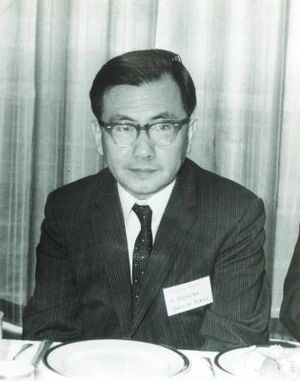Kunihiko Kodaira (nonfiction)
Kunihiko Kodaira (小平 邦彦 Kodaira Kunihiko, 16 March 1915 – 26 July 1997) was a Japanese mathematician known for distinguished work in algebraic geometry and the theory of complex manifolds, and as the founder of the Japanese school of algebraic geometers.
He was born in Tokyo. He graduated from the University of Tokyo in 1938 with a degree in mathematics and also graduated from the physics department at the University of Tokyo in 1941. During the war years he worked in isolation, but was able to master Hodge theory as it then stood. He was involved in cryptographic work from about 1944, while holding an academic post in Tokyo.
He obtained his Ph.D. from the University of Tokyo in 1949, with a thesis entitled Harmonic fields in Riemannian manifolds.
In 1949 he travelled to the Institute for Advanced Study in Princeton, New Jersey at the invitation of Hermann Weyl. At this time the foundations of Hodge theory were being brought in line with contemporary technique in operator theory. Kodaira rapidly became involved in exploiting the tools it opened up in algebraic geometry, adding sheaf theory as it became available. This work was particularly influential, for example on Friedrich Hirzebruch.
In a second research phase, Kodaira wrote a long series of papers in collaboration with D. C. Spencer, founding the deformation theory of complex structures on manifolds. This gave the possibility of constructions of moduli spaces, since in general such structures depend continuously on parameters. It also identified the sheaf cohomology groups, for the sheaf associated with the holomorphic tangent bundle, that carried the basic data about the dimension of the moduli space, and obstructions to deformations.
He was awarded a Fields Medal in 1954, being the first Japanese national to receive this honor.
In a third major part of his work, Kodaira worked again from around 1960 through the classification of algebraic surfaces from the point of view of birational geometry of complex manifolds. This resulted in a typology of seven kinds of two-dimensional compact complex manifolds, recovering the five algebraic types known classically; the other two being non-algebraic. He provided also detailed studies of elliptic fibrations of surfaces over a curve, or in other language elliptic curves over algebraic function fields, a theory whose arithmetic analogue proved important soon afterwards. This work also included a characterization of K3 surfaces as deformations of quartic surfaces in P4, and the theorem that they form a single diffeomorphism class.
Kodaira left the Institute for Advanced Study in 1961, and briefly served as chair at the Johns Hopkins University and Stanford University. In 1967, returned to the University of Tokyo. He was awarded a Wolf Prize in 1984/5. He died in Kofu on 26 July 1997.
In the News
Fiction cross-reference
Nonfiction cross-reference
- Walter Lewis Baily, Jr. (nonfiction) - Doctoral student
- Friedrich Hirzebruch (nonfiction) - Influenced
- Shigeru Iitaka (nonfiction) - Doctoral student
- Shokichi Iyanaga (nonfiction) - Doctoral advisor
- Kodaira dimension (nonfiction)
- Mathematician (nonfiction)
- Yoichi Miyaoka (nonfiction) - Doctoral student
- Hermann Weyl (nonfiction)
External links:
- Kunihiko Kodaira @ Wikipedia
